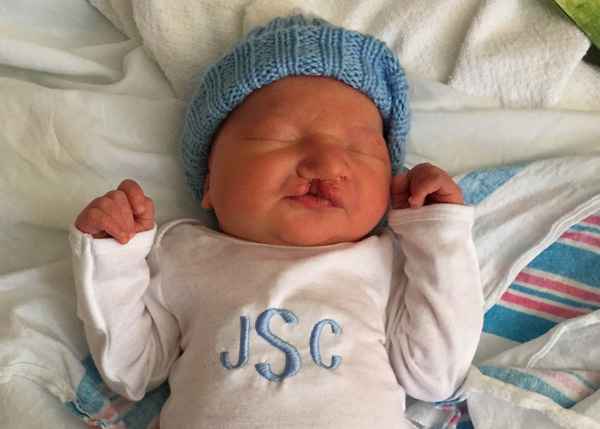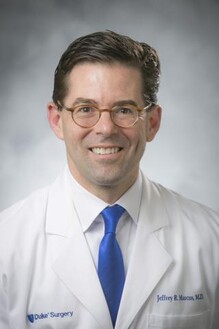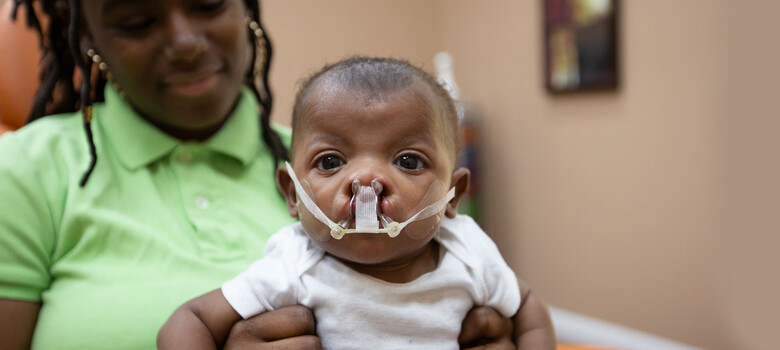Repairing Cleft Lip and Cleft Palate with Fewer Surgeries

Scott, Jack, and Kristin Stroud smile outside their home in Raleigh. Both Kristin and her son Jack were born with a cleft lip and palate.
When Jack Stroud was born with a cleft lip and cleft palate, his parents were prepared. Their son’s birth defect was detected during a pregnancy ultrasound, which gave the couple time to research where he would receive his care. Jack began seeing specialists at Duke during his first week of life. Just four years later, it’s nearly impossible to tell he was born with a cleft lip and palate.
A Family History of Cleft Lip and Cleft Palate
Kristin Stroud, 37, is intimately familiar with her son’s condition because she was born with a cleft lip and palate, too. She had the first of 10 surgeries to repair her defect when she was three months old, the last when she reached adulthood. As soon as she saw her son’s ultrasound, she started researching options to repair the opening that ran through his lip, gum, and the roof of his mouth -- also referred to as the palate.
“I didn’t want him to have the same experience I did,” she said.
Immediately after birth, Jack began seeing Duke craniofacial orthodontist Pedro Santiago, DMD, and pediatric plastic and reconstructive surgeon Jeffrey Marcus, MD.
Stroud had considered other hospitals in the region that treat cleft lip and palate -- including her Duke-rival alma mater -- but chose Duke because of its doctors’ level of expertise.

“I was still having revision surgery in my 20s,” said Jack's mom, Kristin Stroud. “I didn’t want him to have the same experience I did.”
NAM Device Eliminates Need for Major Surgeries Later in Life
Cleft palate treatment has changed dramatically since Stroud was a child. Today, a technique called nasoalveolar molding (NAM) is often the first step. It was for Jack. The NAM involves a custom orthotic device that’s worn in the mouth to help reduce the severity of the cleft palate prior to surgery. It works by gradually shrinking the width of the opening and reshaping the nose while newborn tissues are still soft.
“The use of NAM has nearly eliminated the need for major revision surgeries later in life,” Dr. Marcus said. “However, it’s only available from highly skilled orthodontists. Dr. Santiago helped develop the technique in the 1990s and is considered one of the world’s most experienced NAM specialists.”
Jack wore the NAM device 24/7 for about 12 weeks. When he was three months old, Dr. Marcus repaired his cleft lip. When Jack turned one, Dr. Marcus repaired the opening in the roof of his mouth, and when he was four, Dr. Marcus fixed some muscles near the back of the mouth -- a procedure that will help Jack speak normally.
“New lip reconstruction techniques produce more natural results with minimal scarring,” said Dr. Marcus. “This surgical approach, when combined with NAM, means kids born with cleft lips or palates today need fewer surgeries. And we can offer these treatments at a young age, so most kids don’t even remember having them.”

Results That Will Last a Lifetime
Speech therapy is helping Jack develop normal speech patterns. But what’s even more important to Stroud is that her son had to undergo far fewer surgeries than she did.
“I was still having revision surgery in my 20s,” she said. “Jack hasn’t even started kindergarten yet, and you can’t even tell he had a cleft lip or palate. Instead of being defined by his defect, he’ll know it’s just something he happened to be born with that was then corrected -- no big deal.”
Dr. Marcus said time will tell whether Jack needs more surgeries. Some kids need a bone graft in the gum line to support their teeth. Others may choose nose surgery to improve breathing or appearance once they reach adolescence.
“I’m very happy with Jack’s outcome,” said Dr. Marcus. “Kids just want to be like other kids, and now there is no reason for Jack to have any less confidence in who he is.”



